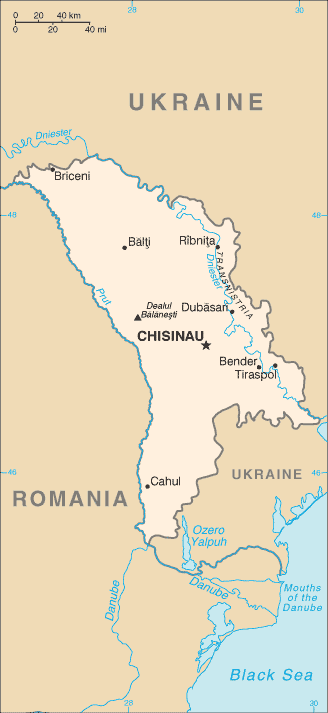|
Moldova
|

|
Capital: Chisinau (Kishinev)
Population: 4,043,263
Brief History of Moldova:
Moldova was known in early history as Bessarabia. Due to its central location, Moldova acted as a passageway between Asia and southern Europe for many years. It also became the site for many wars to be fought and the land changed hands between empires many times throughout its history. Different invaders included the Greeks, Romans, Huns, Bulgars, and Mongols.
For a short time in the 14th century, an independent Moldova emerged under Moldovan hero Stefan the Great. However, in the 16th century the Ottoman Empire conquered the area.
As a result of the Russo-Turkish War, Moldova was split up with the eastern half going to Russian and the western half remaining with Turkey. Romania took control of the Russian half in 1918.
During World War II Romania joined the German side in an effort to attack the Soviet Union. They crossed the border in Bessarabia and deported the Jews. Few of the 185,000 Jews survived until the Russians reoccupied the area in 1944.
When the Soviet Union collapsed in 1990, Moldova declared its independence. Its move toward democracy and a market economy has not been easy.
Moldova has a number of ethnic groups within the country including Romanian, Ukrainian, Russian, and Bulgarian. The official language is Moldovan, which is the same as Romanian, but Russian, Ukrainian and Gagauz are also spoken by many of its residents.
The Geography of Moldova
Total Size: 33,843 square km
Size Comparison: slightly larger than Maryland
Geographical Coordinates: 47 00 N, 29 00 E
World Region or Continent: Europe
General Terrain: rolling steppe, gradual slope south to Black Sea
Geographical Low Point: Dniester River 2 m
Geographical High Point: Dealul Balanesti 430 m
Climate: moderate winters, warm summers
Major cities: CHISINAU (capital) 650,000 (2009)
The People of Moldova
Type of Government: republic
Languages Spoken: Moldovan (official, virtually the same as the Romanian language), Russian, Gagauz (a Turkish dialect)
Independence: 27 August 1991 (from Soviet Union)
National Holiday: Independence Day, 27 August (1991)
Nationality: Moldovan(s)
Religions: Eastern Orthodox 98%, Jewish 1.5%, Baptist and other 0.5% (2000)
National Symbol: aurochs (a type of wild cattle)
National Anthem or Song: Limba noastra (Our Language)
Economy of Moldova
Major Industries: sugar, vegetable oil, food processing, agricultural machinery; foundry equipment, refrigerators and freezers, washing machines; hosiery, shoes, textiles
Agricultural Products: vegetables, fruits, wine, grain, sugar beets, sunflower seed, tobacco; beef, milk
Natural Resources: lignite, phosphorites, gypsum, arable land, limestone
Major Exports: foodstuffs, textiles, machinery
Major Imports: mineral products and fuel, machinery and equipment, chemicals, textiles (2000)
Currency: Moldovan leu (MDL)
National GDP: $12,000,000,000
** Source for population (2012 est.) and GDP (2011 est.) is CIA World Factbook.
Back to Geography Home Page
